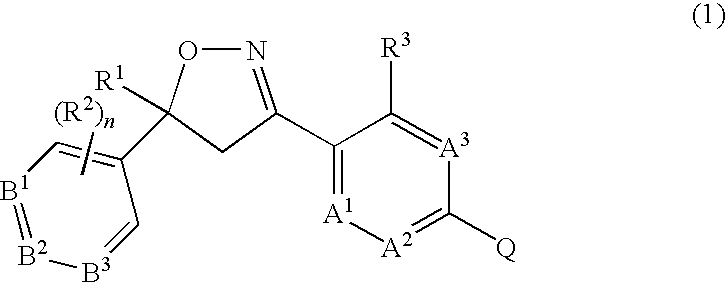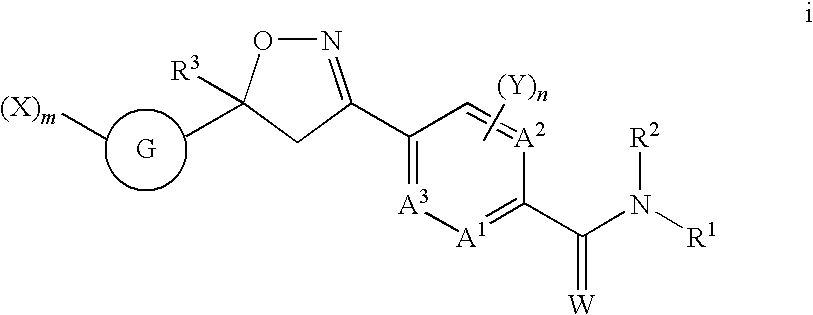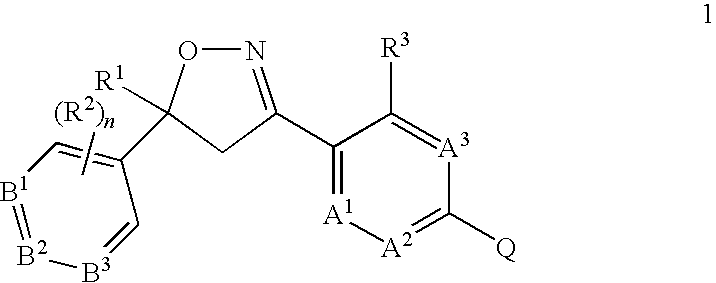5-Aryl Isoxazolines for Controlling Invertebrate Pests
a technology of invertebrate pests and aryl isoxazolines, which is applied in the field of isoxazolines, can solve the problems of increasing consumer costs and significant productivity reduction
- Summary
- Abstract
- Description
- Claims
- Application Information
AI Technical Summary
Benefits of technology
Problems solved by technology
Method used
Image
Examples
example 1
Preparation of 5-(3,5-dichlorophenyl)-4,5-dihydro-3-[4-(1H-pyrazol-1-yl)phenyl]-5-(trifluoromethyl)isoxazole
Step A: Preparation of 1,3-dichloro-5-[1-(trifluoromethyl)ethenyl]benzene
[0339]To a mixture of tetrahydrofuran (33 mL), ethylene glycol dimethyl ether (33 mL), and 4 N aqueous potassium hydroxide (33 mL) in a 200 mL Fisher-Porter sealed tube was added 3,5-dichlorophenylboronic acid (8.72 g, 45.7 mmol) and 2-bromo-3,3,3-trifluoro-propene (10.0 g, 57.2 mmol), followed by the addition of tetrakis(triphenylphosphine)-palladium(0) (264 mg, 0.229 mmol). The mixture was heated to 75° C. for 3 h. Then the reaction mixture was partitioned between diethyl ether and water. The aqueous extract was washed with diethyl ether (2×20 mL). The organic extracts were combined, dried (MgSO4), and concentrated under reduced pressure to provide a residue. The residue was purified by silica gel chromatography and eluted with hexane to afford 4.421 g of the title compound as a clear oil.
[0340]1H NMR (...
example 2
Preparation of 5-(3,5-dichlorophenyl)-4,5-dihydro-3-[3-methyl (1H-pyrazol-1-yl)phenyl]-5-(trifluoromethyl)isoxazole
Step A: Preparation of [C(E)]-4-fluoro-3-methylbenzaldehyde oxime
[0343]To a solution of 4-fluoro-3-methylbenzaldehyde (5.0 g, 36.2 mmol) in ethanol (100 mL) was added 50% by wt hydroxylamine aqueous solution (5.0 mL, 76.0 mmol). The reaction mixture was stirred at room temperature for 3 h. Then the mixture was concentrated under reduced pressure to give a waxy oil, which was purified by silica gel chromatography and eluted with a gradient of 0-25% ethyl acetate in hexane to afford the title compound as a white solid (4.971 g), m.p. 79-80° C.
[0344]1H NMR (CDCl3) δ 8.08 (s, 1H), 7.51 (br s, 1H), 7.43 (d, 1H), 7.36 (m, 1H), 7.01 (t, 1H), 2.29 (s, 3H).
Step B: Preparation of 5-(3,5-dichlorophenyl)-3-(4-fluoro-3-methylphenyl)-4,5-dihydro-5-(trifluoromethyl)isoxazole
[0345]To a solution of [C(E)]-4-fluoro-3-methylbenzaldehyde oxime (i.e. the product of Step A) (4.971 g, 32.5 mm...
example 3
Preparation of 2-[4-[5-(3,5-dichlorophenyl)-4,5-dihydro-5-(trifluoromethyl)-3-isoxazolyl]phenyl]pyridine
Step A: Preparation of [C(E)]-4-(2-pyridinyl)benzaldehyde oxime
[0349]A solution of 4-(pyridine-2-yl)benzaldehyde (1.83 g, 0.01 mol), hydroxylamine hydrochloride (0.7 g, 0.01 mol), and sodium acetate (0.33 g) in ethanol (17 mL) and water (1 mL) was heated at reflux for 5 h. The reaction mixture was cooled to room temperature, and the resulting precipitate was collected, rinsed with ethanol, and dried under reduced pressure to afford 1.5 g of the title compound as a white solid.
[0350]1H NMR (CDCl3) δ 11.8 (br s, 1H), 8.8 (s, 1H), 8.4 (m, 3H), 8.3 (m, 1H), 7.8 (m, 3H), 7.7 (m, 1H).
Step B: Preparation of 2-[4-[5-(3,5-dichlorophenyl)-4,5-dihydro-5-(trifluoromethyl)-3-isoxazolyl]-phenyl]pyridine
[0351]To a solution of [C(E)]-4-(2-pyridinyl)benzaldehyde oxime (i.e. the product from Step A) (0.2 g, 0.001 mol) and 1,3-dichloro-5-[1-(trifluoromethyl)ethenyl]benzene (i.e. the product from Exa...
PUM
| Property | Measurement | Unit |
|---|---|---|
| composition | aaaaa | aaaaa |
| adhesive | aaaaa | aaaaa |
| weight | aaaaa | aaaaa |
Abstract
Description
Claims
Application Information
 Login to View More
Login to View More - R&D
- Intellectual Property
- Life Sciences
- Materials
- Tech Scout
- Unparalleled Data Quality
- Higher Quality Content
- 60% Fewer Hallucinations
Browse by: Latest US Patents, China's latest patents, Technical Efficacy Thesaurus, Application Domain, Technology Topic, Popular Technical Reports.
© 2025 PatSnap. All rights reserved.Legal|Privacy policy|Modern Slavery Act Transparency Statement|Sitemap|About US| Contact US: help@patsnap.com



